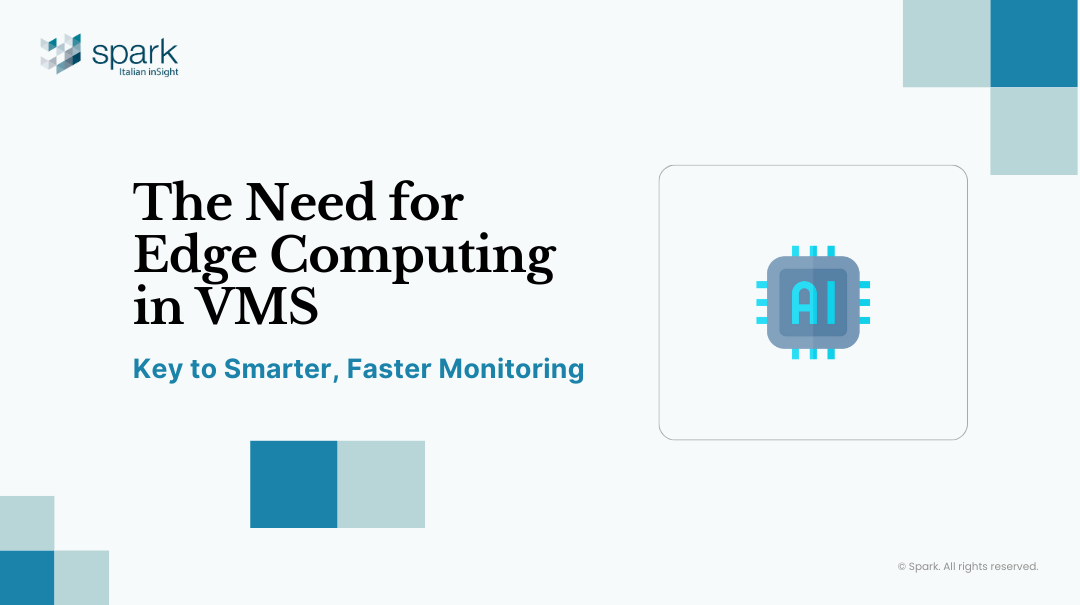2025.09.05
Why Does VMS Need Edge Computing?
With smart security and smart cities on the rise, video surveillance has advanced into AI-powered VMS with real-time analysis and alerts. But cloud-based systems often face bandwidth limits, high latency, and delayed responses.
Edge Computing solves this by running AI at the data source, processing video locally to cut latency, boost responsiveness, and enable real-time decisions. In modern smart city and public safety applications, traditional surveillance is no longer enough—AI plus edge computing is essential.
Core Advantages of Edge Computing
Edge Computing means processing data at or near the source—such as cameras, sensors, or edge servers—instead of transmitting everything to distant cloud centers.
For AI VMS, this brings several key benefits:
-
Lower Latency
Analysis results are generated locally, enabling faster responses for time-critical scenarios like intrusion detection or fire/smoke alerts. -
Bandwidth Efficiency
Each camera can generate tens of MB of data per second. Instead of transmitting raw streams, only “processed results” or “event clips” are sent, reducing network load. -
Higher Reliability
Even if the network is down, edge nodes can continue operating independently, ensuring surveillance continuity. -
Enhanced Privacy & Security
Sensitive data (e.g., faces, license plates) is processed locally, with only necessary metadata or alerts sent upstream, minimizing data exposure risks.

Integration: AI VMS + Edge Computing
To maximize the potential of Argo AI VMS, deep integration with edge computing is essential:
-
Pre-processing
Cameras or edge AI devices perform face recognition, license plate recognition, and smoke/fire detection locally, sending only critical clips to the VMS. -
Event Filtering
Edge AI filters out normal events and forwards only anomalies, saving storage and helping staff focus on real threats. -
Hierarchical Architecture
Edge nodes handle instant responses, while Argo AI VMS manages long-term analysis and cross-site statistics—ideal for buildings, campuses, communities, and city-scale deployments. -
Failover Mechanism
Even if the central system fails, edge devices can continue alarm detection to ensure uninterrupted safety operations.
Typical Application Scenarios
-
Smart Security
In buildings, campuses, or communities, edge AI instantly detects intrusions, loitering, or abnormal behaviors. Argo VMS pushes alerts in real time, without waiting for cloud processing. -
Traffic Management
With edge AI, Argo VMS enables real-time license plate recognition, traffic flow monitoring, and violation detection. Edge nodes process hundreds of video streams and transmit live traffic data to control centers. -
Smart Campuses & Communities
Integrated with smart access control, SIP intercoms, and I/O modules. For example, student card access can trigger video verification, automatically locking doors and alerting guards when anomalies occur. -
Industrial Environments
Edge AI detects unsafe actions (e.g., no helmet), abnormal machine sounds, or rising temperatures. The system can instantly shut down equipment or activate safety measures to prevent accidents.
Challenges & Spark Solutions
Despite its benefits, edge computing poses challenges:
-
Limited Hardware Resources
Edge devices may struggle with multi-stream video processing.
→ Solution: AI VMS Mini/Server supports GPU/NPU acceleration and lightweight AI models for real-time analysis. -
Multi-sensor Integration
Cameras, microphones, smoke, and temperature sensors must sync data.
→ Solution: Argo AI VMS provides a unified interface for multi-sensor data fusion. -
Data Privacy & Governance
Videos often contain sensitive data.
→ Solution: Edge processing ensures only event results or features are transmitted. -
Maintenance & Upgrades
Distributed edge devices are harder to manage.
→ Solution: Centralized remote management via Argo AI VMS.
Future Trends: Edge Computing × AI VMS
-
5G + Edge AI
Ultra-low latency and high bandwidth for real-time applications like autonomous traffic control. -
Lightweight AI Models
Optimized models (e.g., Tiny YOLO, MobileNet) run efficiently on edge devices, cutting costs while boosting performance. -
Hybrid Cloud Architecture
Edge handles instant responses; cloud handles long-term analytics and cross-regional insights. -
Autonomous Security Systems
AI VMS will evolve from passive monitoring to proactive decision-making—automatically locking doors, alerting emergency services, or triggering response protocols.
Through edge computing, Spark Diweico’s Argo AI VMS delivers outstanding performance across various environments: real-time, reliable, and secure.
It not only reduces latency, saves bandwidth, and enhances immediate decision-making, but also safeguards privacy and data security. In the future, across smart cities, campuses, communities, transportation, and industrial settings, AI VMS will evolve from passive monitoring into a proactive, intelligent, and reliable security decision-making hub.
Spark Argo AI VMS: Technical Advantages
-
Spark Argo AI VMS: Technical Advantages
-
Cross-brand compatibility: Supports ONVIF / RTSP for seamless integration with diverse cameras and sensors.
-
Rapid AI integration: Third-party AI modules can be quickly embedded via the Spark SDK.
-
Flexible architecture: From single-site to city-wide deployments, adaptable to local or cloud resources.
-
High reliability: Edge nodes with failover mechanisms keep systems running even during central outages.
→ Contact us to learn more about Argo AI VMS solutions.
Why Does VMS Need Edge Computing?
With smart security and smart cities on the rise, video surveillance has advanced into AI-powered VMS with real-time analysis and alerts. But cloud-based systems often face bandwidth limits, high latency, and delayed responses.
Edge Computing solves this by running AI at the data source, processing video locally to cut latency, boost responsiveness, and enable real-time decisions. In modern smart city and public safety applications, traditional surveillance is no longer enough—AI plus edge computing is essential.
Core Advantages of Edge Computing
Edge Computing means processing data at or near the source—such as cameras, sensors, or edge servers—instead of transmitting everything to distant cloud centers.
For AI VMS, this brings several key benefits:
-
Lower Latency
Analysis results are generated locally, enabling faster responses for time-critical scenarios like intrusion detection or fire/smoke alerts. -
Bandwidth Efficiency
Each camera can generate tens of MB of data per second. Instead of transmitting raw streams, only “processed results” or “event clips” are sent, reducing network load. -
Higher Reliability
Even if the network is down, edge nodes can continue operating independently, ensuring surveillance continuity. -
Enhanced Privacy & Security
Sensitive data (e.g., faces, license plates) is processed locally, with only necessary metadata or alerts sent upstream, minimizing data exposure risks.

Integration: AI VMS + Edge Computing
To maximize the potential of Argo AI VMS, deep integration with edge computing is essential:
-
Pre-processing
Cameras or edge AI devices perform face recognition, license plate recognition, and smoke/fire detection locally, sending only critical clips to the VMS. -
Event Filtering
Edge AI filters out normal events and forwards only anomalies, saving storage and helping staff focus on real threats. -
Hierarchical Architecture
Edge nodes handle instant responses, while Argo AI VMS manages long-term analysis and cross-site statistics—ideal for buildings, campuses, communities, and city-scale deployments. -
Failover Mechanism
Even if the central system fails, edge devices can continue alarm detection to ensure uninterrupted safety operations.
Typical Application Scenarios
-
Smart Security
In buildings, campuses, or communities, edge AI instantly detects intrusions, loitering, or abnormal behaviors. Argo VMS pushes alerts in real time, without waiting for cloud processing. -
Traffic Management
With edge AI, Argo VMS enables real-time license plate recognition, traffic flow monitoring, and violation detection. Edge nodes process hundreds of video streams and transmit live traffic data to control centers. -
Smart Campuses & Communities
Integrated with smart access control, SIP intercoms, and I/O modules. For example, student card access can trigger video verification, automatically locking doors and alerting guards when anomalies occur. -
Industrial Environments
Edge AI detects unsafe actions (e.g., no helmet), abnormal machine sounds, or rising temperatures. The system can instantly shut down equipment or activate safety measures to prevent accidents.
Challenges & Spark Solutions
Despite its benefits, edge computing poses challenges:
-
Limited Hardware Resources
Edge devices may struggle with multi-stream video processing.
→ Solution: AI VMS Mini/Server supports GPU/NPU acceleration and lightweight AI models for real-time analysis. -
Multi-sensor Integration
Cameras, microphones, smoke, and temperature sensors must sync data.
→ Solution: Argo AI VMS provides a unified interface for multi-sensor data fusion. -
Data Privacy & Governance
Videos often contain sensitive data.
→ Solution: Edge processing ensures only event results or features are transmitted. -
Maintenance & Upgrades
Distributed edge devices are harder to manage.
→ Solution: Centralized remote management via Argo AI VMS.
Future Trends: Edge Computing × AI VMS
-
5G + Edge AI
Ultra-low latency and high bandwidth for real-time applications like autonomous traffic control. -
Lightweight AI Models
Optimized models (e.g., Tiny YOLO, MobileNet) run efficiently on edge devices, cutting costs while boosting performance. -
Hybrid Cloud Architecture
Edge handles instant responses; cloud handles long-term analytics and cross-regional insights. -
Autonomous Security Systems
AI VMS will evolve from passive monitoring to proactive decision-making—automatically locking doors, alerting emergency services, or triggering response protocols.
Through edge computing, Spark Diweico’s Argo AI VMS delivers outstanding performance across various environments: real-time, reliable, and secure.
It not only reduces latency, saves bandwidth, and enhances immediate decision-making, but also safeguards privacy and data security. In the future, across smart cities, campuses, communities, transportation, and industrial settings, AI VMS will evolve from passive monitoring into a proactive, intelligent, and reliable security decision-making hub.
Spark Argo AI VMS: Technical Advantages
-
Spark Argo AI VMS: Technical Advantages
-
Cross-brand compatibility: Supports ONVIF / RTSP for seamless integration with diverse cameras and sensors.
-
Rapid AI integration: Third-party AI modules can be quickly embedded via the Spark SDK.
-
Flexible architecture: From single-site to city-wide deployments, adaptable to local or cloud resources.
-
High reliability: Edge nodes with failover mechanisms keep systems running even during central outages.
→ Contact us to learn more about Argo AI VMS solutions.


